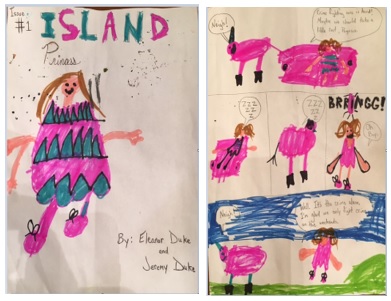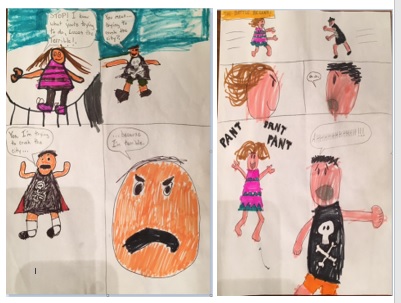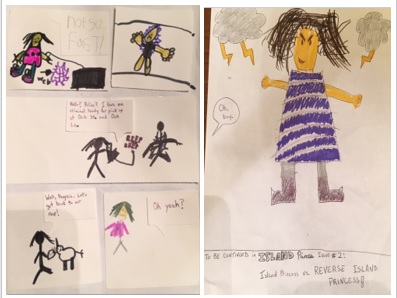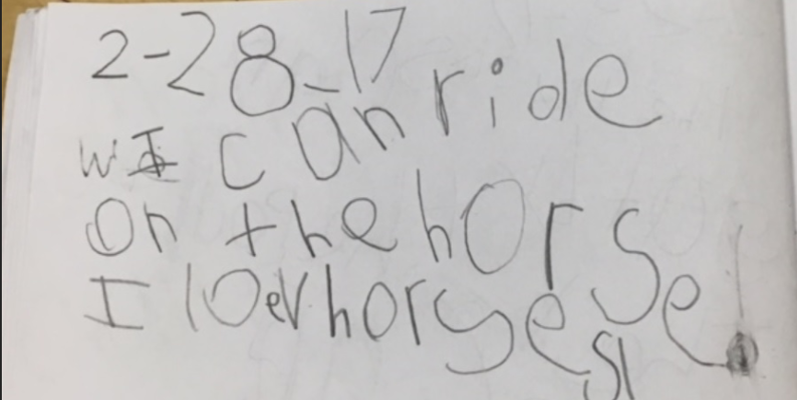When I taught kindergarten years ago my favorite time of the day was writing workshop. I loved modeling a simple lesson, sending students out to write on their own while I moved around the room conferring with as many young writers as time allowed before we closed our notebooks for the day.
They were enthusiastic and excited to write. We wrote from the very first day of school; each day all year long. It was amazing to see how quickly those five and six year olds grew into independent writers.
It’s been more than a decade since I had a roomful of kindergarten students, but in the last few months I’ve been reminded of exactly what it is that young writers need. Our granddaughter, Eleanor, is in kindergarten this year and when I visited them recently she shared her own writing with me.
She and her dad decided to try creating their own comic book. Watching the process they’ve engaged in has reminded me of the essential elements of writing instruction for our youngest writers.

Mentor texts
One of the most challenging bits for any writer is the development of ideas. Eleanor is hooked on Aw Yeah Comics Action Cat by Art Baltazar, so it’s no surprise that she wanted to “borrow” from her literary love. Young writers need to see up close the writer’s craft and idea development so they can try their hand at imitation. I’ve known some teachers who feel uncomfortable with this idea. “Don’t you think it’s bad that they are copying ideas directly from many of the trade books we read in class?” a teacher once asked me.
Not at all.
Young writers need great models to mimic. We should read and read a lot. Then we should encourage our students to engage in “literary borrowing” as they grow toward developing a unique writing voice all their own.

Time to talk
When I asked my son-in-law to describe the process of developing Island Princess (the title of Eleanor’s comic book series), he related how most of their story development takes place on long walks through their neighborhood. Eleanor has an active imagination and loves acting out her hero adventures. As Eleanor and her dad walk, they talk through possible ideas and are able to lay out the story arc through conversation.
Our youngest writers need time to think about ideas and then encouragement and guidance to talk about their writing. Betsy Hubbard describes this process beautifully in her blog post published at Two Writing Teachers a few years ago. She shares her process of how she talks through her own story, then allows students to tell their story to a partner, drawing and sketching before finally leading students to use letter/sound correspondence to write down their stories. Betsy shares, “All of these ideas were born out of my experience and my guide, Talking, Drawing, Writing by Giacobbe and Horn.

Time to write
Eleanor and Jeremy (her dad) set aside time on a fairly regular basis to do the real work of writing. Jeremy shared that after their discussions about story elements they talk about the best way to effectively match illustrations and text. They ask questions about how best to help the reader fully understand the plot and characters. They discuss order of events and ways to show characters’ feelings and motivations.
Without Jeremy’s support, Eleanor might very well find the process of writing and illustrating too daunting a task. Young writers need extended time to try (and fail), but they also need an adult to ask questions, to model author’s craft and to encourage with genuine, productive feedback.
Eleanor’s attempts at fully developing an idea into a piece of writing is teaching her so many valuable lessons. Sure, she’s a novice at this whole writing thing, but she’s already learning that reading and writing are inextricably bound together.
Readers read with writer’s glasses; paying close attention to the author’s craft. Writer’s write with reader’s glasses; applying what they know firsthand about captivating the attention of the reader and leading them on a journey that will linger long after the last page is turned.
It doesn’t matter that they seem too little for the task.
What matters is that we support our youngest writers so they are fully able to do the work of crafting great stories.










Excellent!!! These are ideas I try to use each day. Your confirmation of my thoughts is awesome. Kindergarten should be a bit chaotic and noisy as they learn to write with pictures and add their letter sounds to try words. Thanks.
Kindergarten should absolutely be busy and noisy! Learning is not always still and quiet. So pleased you found confirmation of your practice in kgarten. 🙂